
The Zuiderzee or Zuider Zee was a shallow bay of the North Sea in the northwest of the Netherlands, extending about 100 km inland and at most 50 km wide, with an overall depth of about 4 to 5 metres (13–16 feet) and a coastline of about 300 km. It covered 5,000 km2 (1,900 sq mi). Its name is Dutch for "southern sea", indicating that the name originates in Friesland, to the north of the Zuiderzee.
Horatio Hornblower is a fictional officer in the British Royal Navy during the Napoleonic Wars, the protagonist of a series of novels and stories by C. S. Forester. He later became the subject of films and radio and television programmes, and C. Northcote Parkinson elaborated a "biography" of him, The True Story of Horatio Hornblower.
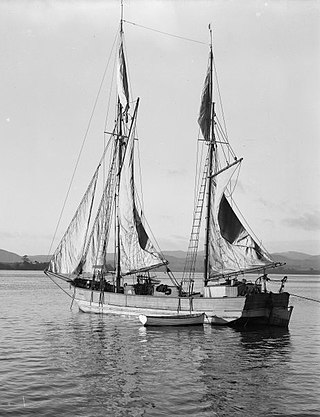
A scow is a smaller type of barge. Some scows are rigged as sailing scows. In the 19th and early 20th centuries, scows carried cargo in coastal waters and inland waterways, having an advantage for navigating shallow water or small harbours. Scows were in common use in the American Great Lakes and other parts of the U.S., Canada, southern England, and New Zealand. In modern times their main purpose is for recreation and racing.

A leeboard is a form of pivoting keel used by a sailboat largely and very often in lieu of a fixed keel. Typically mounted in pairs on each side of a hull, leeboards function much like a centreboard, allowing shallow-draft craft to ply waters fixed keel boats cannot. Only the leeward side leeboard is used at any time, as it submerges when the boat heels under the force of the wind.
A pram or pramm describes a type of shallow-draught flat-bottomed ship, usually propelled by pushing the ship through the water using a long pole, although sailing prams also exist. The name pram derives from the Latin premere.
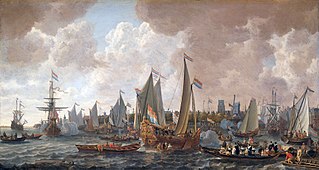
HMY Mary was the first Royal Yacht of the Royal Navy. She was built in 1660 by the Dutch East India Company. Then she was purchased by the City of Amsterdam and given to King Charles II, on the restoration of the monarchy, as part of the Dutch Gift. She struck rocks off Anglesey in thick fog on 25 March 1675 while en route from Dublin to Chester. Although 35 of the 74 crew and passengers were killed as the wreck quickly broke up, 39 managed to get to safety. The remains were independently discovered by two different diving groups in July 1971. After looters started to remove guns from the site, a rescue operation was organized and the remaining guns and other artifacts were taken to the Merseyside Museums for conservation and display. After the passing of the Protection of Wrecks Act 1973, she was designated as a protected site on 20 January 1974.
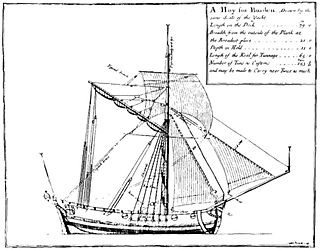
A hoy is a small sloop-rigged coasting ship or a heavy barge used for freight, usually with a burthen of about 60 tons (bm). The word derives from the Middle Dutch hoey. In 1495, one of the Paston Letters included the phrase, An hoye of Dorderycht, in such a way as to indicate that such contact was then no more than mildly unusual. The English term was first used on the Dutch Heude-ships that entered service with the Royal Navy.

A Dutch barge is a traditional flat-bottomed shoal-draught barge, originally used to carry cargo in the shallow Zuiderzee and the waterways of Netherlands. There are many types of Dutch barge, with characteristics determined by regional conditions and traditions.

The Téméraire-class ships of the line were a class of a hundred and twenty 74-gun ships of the line ordered between 1782 and 1813 for the French navy or its attached navies in dependent (French-occupied) territories. Although a few of these were cancelled, the type was and remains the most numerous class of capital ship ever built to a single design.

Rivoli was a Téméraire-class ship of the line of the French Navy. Rivoli was built in the Arsenal of Venice, whose harbour was too shallow for a 74-gun to exit. To allow her to depart, she was fitted with seacamels.

The Battle of Pirano on 22 February 1812 was a minor naval action of the Adriatic campaign of the Napoleonic Wars fought between a British and a French ship of the line in the vicinity of the towns of Piran and Grado in Adriatic Sea. The French Rivoli, named for Napoleon's victory 15 years earlier, had been recently completed at Venice. The French naval authorities intended her to bolster French forces in the Adriatic, following a succession of defeats in the preceding year.
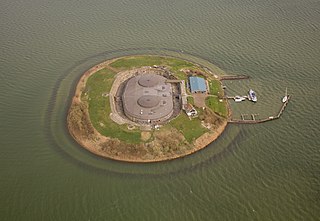
Pampus is an artificial island and late 19th-century sea fort located in the IJmeer near Amsterdam. Pampus now belongs to the municipality of Gooise Meren and is open to visitors.
A sailing barge is a kind of barge propelled by sails. Traditional types of sailing barges include:
Mathurin François Boucher was a French naval engineer. He is notable for his adaptation of the technique of ship camel to large 74-guns, and for designing the Surveillante class of 60-gun frigates.

SB Centaur is a wooden Thames sailing barge, built in Harwich, Essex, England in 1895. She was used to carry various cargoes, mainly grain, for the next 60 years. During the First World War she carried food and coal to the French Channel ports. During the Second World War Centaur was damaged when sailing to assist with the Dunkirk Evacuation. She did war work for the duration of the conflict.

Mirosa is a Thames barge which was built in 1892. From 1892 until 1947, she sailed under the name Ready when the name was sold to Trinity House for a lightship support vessel. Under her new name, she traded until 1955. Mirosa has never had an engine.
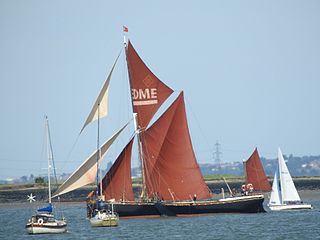
Edme is a Thames barge which was built in 1898 for the Horlocks of Mistley. She was registered in Harwich. She is one of two barge sailing today that have no auxiliary engine.
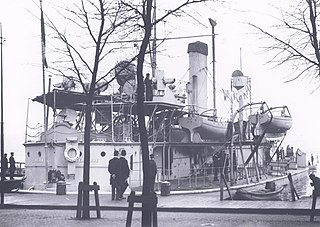
HNLMS Cerberus, was a Heiligerlee-class monitor built in Amsterdam for the Royal Netherlands Navy in the 1860s. Cerberus was a true monitor: a ship with shallow draught, only a few (heavy) guns and decent armor. These characteristics made her very suitable to operate way inland in the Dutch delta.

The Haarlemmermeer class was a class of nine gunvessels of the Royal Netherlands Navy. The class was a failure because of its extreme susceptibility to dry rot.


















